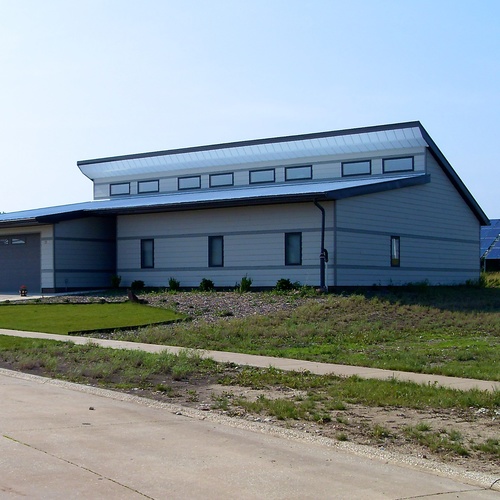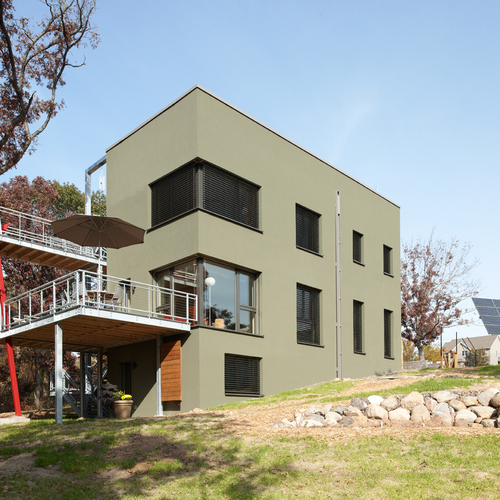
Garbage Garage:
One of the projects detailed on the GreenBridge blog is a garage whose lower walls consist of auto tires filled with rammed earth.Image Credit: GreenBridge
Juli MacDonald is an architect and accredited LEED professional who worked in Chicago for 20 years before relocating to the East Coast and eventually opening her own firm in Amesbury, Massachusetts, in 2007.
Later that year she started writing the GreenBridge blog. It’s named after her firm, which concentrates on residential additions and remodels.
GreenBridge Blog is a mix of project descriptions, “sustainability and efficiency” entries, which covers such topics as insulation, home office planning and green roofs, and a shorter travelogue section that details places she’s visited or conferences she’s attended.
There’s nothing stiff or pedantic about the entries. MacDonald writes just enough about herself and her family to provide personal context, but does not wander so far afield we wish she’s get back on topic.
The project list isn’t huge, but there are some interesting entries, including one called the “Garbage Garage.” The handsome building looks conventional, until you get into the details and find out its lower walls are rammed-earth tires, and that light in the upper gable ends comes from glass bottles laid up like cordwood and mortared in place. A visiting team from Guatemala called Long Way Home took part in the project.
Another is Lamorna Cottage after a 1880s farmhouse that MacDonald and her family seem to have bought this past summer in Rockland, Maine. We’ll be traveling along as they bring the house back into livable shape.
There also are links to companies that might be of interest to anyone building in New England, including Andros Energy (renewable energy systems), the Green Cocoon (insulation), and JF Jewett Farms & Co. (cabinetmakers).
Here are a few excerpts:
Reuse and salvage
One of my fondest memories of living in Chicago was ‘shopping’ in the alleys. My quickest walk to the train was down our 3 block alley: on one side were condo buildings and the on the other were single-family homes. It worked this way – if you didn’t want something anymore, you left it in the alley, NEXT to the garbage, sometimes with a note, and it was usually gone in a few hours. Through the years I collected a great variety of treasures. Among them: lamps, a desk, many, many chairs, my now favorite cookbook. My goal wasn’t to be green, but it really was an efficient (cheap!) and practical system.
Now I use Freecycle. If you haven’t checked them out, give them a try – it is basically a local list-serve where members post items they want to give away or items they’d like to receive. It works similarly to shopping in the Chicago alley, but is a bit more civilized.
In construction, the act of restoring or remodeling a home is a form of reuse and salvage. Preservation instead of demolition and new construction saves in energy and materials consumption and reduces demolition landfill. There is a great opportunity in salvaging and reusing materials for remodeling and even new construction projects, if you are aware and know where to look.
When to save old windows
One of the most wonderful aspects of our local architecture is its historic windows with their characteristic divided lite panes and historic glass. They are not only visually appealing, but their design and craftsmanship make them worthy of preservation. Unfortunately, because they are single-glazed and often in disrepair, they are also one of the largest sources of heat loss in winter and a major source of heat gain in the summer. The windows alone can be responsible for 25 to 50 percent of the energy used to heat and cool homes!
… There is a point when the condition of the window clearly indicates that a replacement is necessary. When considering replacement windows, it is important to not only consider their energy efficiency, but also their appearance in terms of the pattern of the proportions of their frame and sash, the configuration of the window panes, muntin profiles, types of wood and characteristics of the glass. Search for a replacement that retains as much of the character of the historic window as possible.
Why we should talk about toilets
When I first started working as an architectural intern in Rockford, Illinois, Larry, the curmudgeonly head draftsman, loved teasing me about my main job of drawing toilet rooms. He didn’t let me say ‘bathroom,’ insisting that I say ‘toilet.’ He was right – we were working on commercial toilet rooms and nobody was taking baths there… Well, it’s been a lot of years, and now I’ve got a lot to say about toilets – Do you want your toilet in a separate room? Do you like an elongated bowl for comfort? What do you think of the water-saving dual-flush models? Do you have young sons?
Discussing the toilet still isn’t my favorite part of the bath design process, but it’s important, because habits and details make all the difference in a successful bathroom.
I resolve
On December 12th [2009], my family lost my Grandmother, Eleanor Phillips, who lived in Fort Dodge, Iowa. I was lucky enough to be able to spend some precious time with her during her last days in the hospital. During part of that time, my cousins and I pored over Grandma’s various journals, letters and photos, and we got a wonderful sense of the fullness of her life and the way she lived and adapted throughout her 88 years.
In one letter to her sister written in the 50s, she talked about ripping down discarded clothing to make braided rugs. Her journals and autobiographies described her huge love of gardening and enjoyment of the harvests. She was a farmer’s daughter, one of 6 children who knew what sharing and making-do meant, and who also knew to not leave the table without asking one sibling or parent to guard her plate. Her fondest memories of her mother included her ability to whip up the most amazing donuts for the family and to make a dress for my grandmother the night before she wore it to a dance.
It was clear that she had a happy childhood – she carried a 80-year-old snapshot of a family Sunday picnic in her wallet, and in her writing she often described her many memories of her parents hugging and kissing, and her father’s desolation when her mother died at a very young age. She remembered her and her siblings’ excitement at seeing their single gift and one orange next to their plates Christmas morning.
So, my resolution? To continue to carry my grandma and her lessons with me. Embrace simple and good living, enjoy family and seek happiness in the smallest things. She didn’t live her life with the intent of being ‘green’ or ‘sustainable,’ but her way of life was what so many of us strive for today.
Weekly Newsletter
Get building science and energy efficiency advice, plus special offers, in your inbox.















0 Comments
Log in or create an account to post a comment.
Sign up Log in